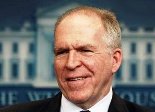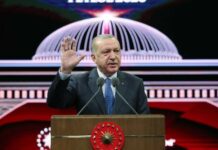 White House counterterror chief John Brennan has seized the lead in guiding the debate on which terror leaders will be targeted for drone attacks or raids, establishing a new procedure to vet both military and CIA targets.
White House counterterror chief John Brennan has seized the lead in guiding the debate on which terror leaders will be targeted for drone attacks or raids, establishing a new procedure to vet both military and CIA targets.
The move concentrates power over the use of lethal U.S. force outside war zones at the White House.
The process, which is about a month old, means Brennan’s staff consults the Pentagon, the State Department and other agencies as to who should go on the list, making a previous military-run review process in place since 2009 less relevant, according to two current and three former U.S. officials aware of the evolution in how the government targets terrorists.
In describing Brennan’s arrangement to The Associated Press, the officials provided the first detailed description of the military’s previous review process that set a schedule for killing or capturing terror leaders around the Arab world and beyond. They spoke on condition of anonymity because U.S. officials are not allowed to publicly describe the classified targeting program.
One senior administration official argues that Brennan’s move adds another layer of review that augments rather than detracts from the Pentagon’s role. The official says that in fact there will be more people at the table making the decisions, including representatives from every agency involved in counterterrorism, before they are reviewed by senior officials and ultimately the president.
The CIA’s process remains unchanged, but never included the large number of interagency players the Pentagon brought to the table for its debates.
And the move gives Brennan greater input earlier in the process, before senior officials make the final recommendation to President Barack Obama. Officials outside the White House expressed concern that drawing more of the decision-making process to Brennan’s office could turn it into a pseudo military headquarters, entrusting the fate of al-Qaida targets to a small number of senior officials.
Previously, targets were first discussed in meetings run by the chairman of the Joint Chiefs of Staff, Adm. Mike Mullen at the time, with Brennan being just one of the voices in the debate.
The new Joint Chiefs chairman, Gen. Martin Dempsey, has been more focused on shrinking the U.S. military as the Afghan war winds down and less on the covert wars overseas.
With Dempsey less involved, Brennan believed there was an even greater need to draw together different agencies’ viewpoints, showing the American public that al-Qaida targets are chosen only after painstaking and exhaustive debate, the senior administration official said.
But some of the officials carrying out the policy are equally leery of “how easy it has become to kill someone,” one said. The U.S. is targeting al-Qaida operatives for reasons such as being heard in an intercepted conversation plotting to attack a U.S. ambassador overseas, the official said. Stateside, that conversation could trigger an investigation by the Secret Service or FBI.
The CIA and the Pentagon did not respond to requests for comment.
Drone strikes are highly controversial in Pakistan, too. Obama met briefly on the sidelines of the NATO summit in Chicago on Monday with Pakistani President Asif Ali Zardari and Afghan President Hamid Karzai.
Pakistan has closed key transit routes used by NATO to send supplies to troops in Afghanistan in response to a U.S. airstrike that killed two dozen Pakistani soldiers.
An example of a recent Pentagon-led drone strike was the fatal attack in January on al-Qaida commander Bilal al-Berjawi in Somalia. U.S. intelligence and military forces had been watching him for days. When his car reached the outskirts of Mogadishu, the drones fired a volley of missiles, obliterating his vehicle and killing him instantly. The drones belonged to the elite U.S. Joint Special Operations Command. The British-Lebanese citizen al-Berjawi ended up on the JSOC list after a studied debate run by the Pentagon.
The Defense Department’s list of potential drone or raid targets is about two dozen names long, the officials said. The previous process for vetting them, now mostly defunct, was established by Mullen early in the Obama administration, with a major revamp in the spring of 2011, two officials said.
Drone attacks were split between JSOC and the CIA, which keeps a separate list of targets, though it overlaps with the Pentagon list. By law, the CIA can target only al-Qaida operatives or affiliates who directly threaten the U.S. JSOC has a little more leeway, allowed by statue to target members of the larger al-Qaida network.
Under the old Pentagon-run review, the first step was to gather evidence on a potential target. That person’s case would be discussed over an interagency secure video teleconference, involving the National Counterterrorism Center and the State Department, among other agencies. Among the data taken into consideration: Is the target a member of al-Qaida or its affiliates; is he engaged in activities aimed at the U.S. overseas or at home?
If a target isn’t captured or killed within 30 days after he is chosen, his case must be reviewed to see if he’s still a threat.
The CIA’s process is more insular. Only a select number of high-ranking staff can preside over the debates run by the agency’s Covert Action Review Group, which then passes the list to the CIA’s Counterterrorism Center to carry out the drone strikes. The Director of National Intelligence, Jim Clapper, is briefed on those actions, one official said.
Al-Berjawi’s name was technically on both lists – the Pentagon’s and the CIA’s. In areas where both JSOC and the CIA operate, the military task force commander and CIA chief of station confer, together with representatives of U.S. law enforcement, on how best to hit the target. If it’s deemed possible to grab the target, for interrogation or simply to gather DNA to prove the identity of a deceased person, a special operations team is sent, as in the case of the 2009 Navy SEAL raid against al-Qaida commander Saleh Ali Saleh Nabhan. Nabhan’s convoy was attacked by helicopter gunships, after which the raiders landed and took his body for identification, before burying him at sea.
But if the al-Qaida operative is in transit from Somalia to Yemen by boat, for instance, U.S. security officials might opt to use the Navy to intercept and the FBI to arrest him, officials said.
{CBS News/Matzav.com Newscenter}










